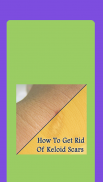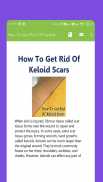








How To Get Rid Of Keloid Scars

Beschreibung von How To Get Rid Of Keloid Scars
Keloid scars are more serious than regular scars and if you are experiencing pain you should consult your doctor, since keloids are at risk for getting infected.
Keloid scars occur when there is an overgrowth of tissue at the site of the healed skin injury. Keloids can vary in color and can be firm and rubbery or shiny and fibrous. The keloid scar is benign and non-contagious but can be accompanied with itching, pains, and changes in the texture of the scar. Keloid scars are sometimes confused with hypertrophic scars, but, the main difference between these two different types is that hypertrophic scars don't grow past the original wound's boundaries but keloid scars do.
Keloid Scar Treatment
1. Topical Creams and other Remedies: You should always start out with a good scar cream as any form of treatment. This is the best way since it is the least costly and invasive form of treatment to remove keloids. Many scar creams out there are not potent enough to treat keloid scars so get the best scar cream for your keloid scar. As long as you get a scar cream that works and apply it correctly and consistently, it can make a huge difference in the appearance of your scar.





















